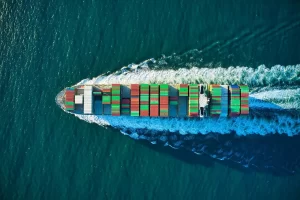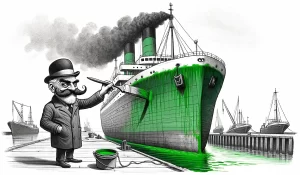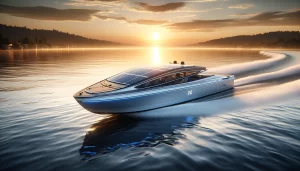At the tail-end of 2022 U.S. Congress approved the 2023 Consolidated Appropriations Act which authorizes funding for numerous U.S. government agencies for the 2023 fiscal year. I’ve summarized the maritime decarbonization relevant sections to save you the trouble of reading the entire text to see who got what.
I’ve summarized the funding provided, what the program or office does, and why it matters for maritime decarbonization. See the full text of the legislation for more detail. If you found this summary helpful, please click some ads, it helps me keep the lights on!
Click the links below to jump to programs under that agency.
-
U.S. Department of TransportationU.S. Department of Transportation
-
U.S. Department of Commerce (NOAA)U.S. Department of Commerce (NOAA)
-
U.S. Department of EnergyU.S. Department of Energy
U.S. Department of Transportation
Maritime Environmental and Technical Assistance
How much: $6 million
What is it: The Maritime Environmental and Technical Assistance (META) program is the one group within the Maritime Administration (MARAD) that funds R&D on technologies that can reduce maritime emissions.
Why it matters: META’s mission space includes both air and water emissions, so this money is effectively reduced by half for R&D for greenhouse gas emissions. This is approximately a 2x increase in funding for this program from years past. A big increase for this office in terms of maritime decarbonization appropriations, but still far, far less than is needed to support R&D and pilot demonstrations of fuels, tools, and technologies that could reduce GHG emissions.
Training Ship Fuel Subsidies
How much: $6.8 million
What is it: Each year the six training ships that are operated by the seven maritime academies receive financial assistance to cover the fuel costs from operating the vessels for training cruises.
Why it matters: This money subsidizes the purchase of diesel fuel for the training ships. I include this section of the legislation to highlight a laughable and sad discrepancy compared to the R&D funding above: the Maritime Administration spends more on fossil fuel subsidies for six ships than it does on R&D for the entire commercial fleet to reduce the emissions from fossil fuel consumption.
Advanced Research Projects Agency - Infrastructure (ARPA-I)
How much: $3.224 million
What is it: ARPA-I is a new program created in the 2022 Bipartisan Infrastructure Bill to support the development of science and technology solutions for infrastructure projects. ARPA-I copies DARPA and ARPA-E (see below), but whereas those focus on defense projects and clean energy respectively, this one will focus on infrastructure R&D.
Why it matters: ARPA-I will likely fund early-stage technologies that could have big impacts on infrastructure, and included within its scope is “harbors”. Conceivably, this could include electrification projects or other shoreside infrastructure that supports maritime operations and emissions reductions.
Local and Regional Project Assistance Program
How much: $800 million in addition to previously announced $1.5 billion
What is it: Funds for the fiscal 2022 RAISE grant program — referred to as the Local and Regional Project Assistance Program in the Bipartisan Infrastructure Law — are to be awarded on a competitive basis for surface transportation infrastructure projects that will have a significant local or regional impact on safety, economic competitiveness, and environmental sustainability, among other factors.
Why it matters: While RAISE grants are largely geared towards surface infrastructure projects, port infrastructure, including inland port infrastructure and a land port-of-entry, are also eligible entities. This funding could help fund construction of low- and zero-carbon infrastructure projects at ports – the Department of Transportation is encouraging applicants to consider how their projects can address climate change in their applications. This could be important program going forward for maritime decarbonization.
Marine Highway Program
How much: $10 million
What is it: America’s Marine Highway Program provides special funding to 29 maritime routes designated as ‘marine highways’ across the U.S. that help to move freight and reduce landside congestion.
Why it matters: The Marine Highway Program is a long-standing program that creates designated marine highways, and the companies that operate on them are eligible to apply for grants from a special funding program reserved for those routes. In my opinion this program is extremely well-suited to support green shipping corridor development and I hope some of this infrastructure funding can support deployment of alternative fuels or maritime electrification on these routes.
Assistance to Small Shipyards
How much: $20 million
What is it: The Maritime Administration’s Small Shipyard Grant Program is designed to support small shipyard projects that make capital and related improvements; or provide training for workers in shipbuilding, ship repair, and associated industries.
Why it matters: This long-standing program at MARAD helps small shipyards with capital projects that improve capabilities or capacity of the yard. The U.S. has a relatively small fleet of 150 large ocean-going vessels engaged in transoceanic trade. On the other hand the U.S. commercial fleet numbers approximately 38,000 when one considers smaller vessels like tugs, fishing boats, ferries, etc. Many of these smaller ships can be built in these ‘small shipyards’. These yards will be crucial in supporting the buildout of the U.S. fleet and encouraging the transition to low- and zero-carbon vessels that we desperately need.
Port Infrastructure Development Program (PIDP)
How much: $212.2 million
What is it: The Port Infrastructure Development Program (PIDP) is a discretionary grant program administered by the MARAD. Funds for the PIDP are awarded on a competitive basis to projects that improve the safety, efficiency, or reliability of the movement of goods into, out of, around, or within a port. Recent changes to the scope of the PIDP has also allowed projects that reduce emissions from maritime activities, including port electrification projects such as provisioning shore-power connections at berths. The funding here is in addition to funding made available through the Bipartisan Infrastructure Law.
Why it matters: The PIDP is one of the largest sources of funding available for infrastructure projects at U.S. ports, especially those on the coast and in the Great Lakes. The Bipartisan Infrastructure Law gave this program a huge boost in funding, and this omnibus funding is in addition to that, so there should be approximately $660 million available in the 2023 fiscal year. The PIDP can be used for a variety of infrastructure projects to include port electrification and alternative fuel infrastructure for hydrogen and methanol, as examples. PIDP will be very important for maritime decarbonization infrastructure projects in the U.S.
U.S. Department of Commerce
Right Whale Conservation and Mitigation Assistance
How much: $50 million each year through 2032
What is it: Creates a new program to provide competitive financial assistance, cooperative agreements, grants, and direct payment to projects designed to develop, assess, and carry out activities that reduce human induced threats to North Atlantic right whales, including: innovative gear technologies, monitoring, and training. This is mostly targeted at reducing the harmful effects of fishing gear entanglements and vessel collisions.
Why it matters: You might be asking yourself, “what does protecting right whales have to do with maritime decarbonization?” Vessel collisions with whales aren’t uncommon, and one of the more effective ways to reduce these dangerous encounters is by having vessels simply slow down when transiting areas known to have whales. When a vessel slows down, it uses substantially less fuel and produces far fewer emissions. Therefore, vessel speed reduction not only protects whales, but also helps to reduce maritime GHG emissions.
U.S. Department of Energy
Office of Energy Efficiency and Renewable Energy (EERE)
How much: $3.46 billion
What is it: EERE is a conglomeration of approximately a dozen smaller line offices within the U.S. Department of Energy that focuses on renewable power technologies, sustainable transport, and energy efficiency. There are a handful of offices within EERE that work on maritime issues, including the Water Power Technologies Office, the Vehicles Technologies Office, Wind Energy Technologies Office, the Bioenergy Technologies Office, and the Hydrogen and Fuel Cell Technologies Office. This funding within EERE goes to applied energy research in the form of competitive grants awarded to U.S. National Laboratories, academic institutions, and the private sector for a host of clean energy technologies.
Why it matters: This funding is spread over about a dozen offices working on everything from solar PV to geothermal heat pumps to wave energy. A very small amount of this total funding, maybe around $2 million to $10 million, will go directly towards maritime specific projects. Due to the way EERE is structured and how offices are allowed to use this funding, the little bit of funding that does wind-up in specific maritime decarbonization projects will likely be for biofuels and hydrogen research.
Office of Electricity
How much: $350 million
What is it: The Office of Electricity has many sub-offices and focuses on enabling an electricity delivery system that is secure and resilient to disruptions. Like EERE they also provide competitive grants and support energy research and improvements to our nation’s electrical infrastructure and microgrid development.
Why it matters: The Office of Electricity will be particularly important for maritime electrification. In the not-so-distant future the ports will become hubs of enormous electricity demand from all-electric and hybrid cargo handling equipment, cold-ironing ships, all-electric and hybrid ships, and even potentially e-fuel production. This will require major investments in grid infrastructure in and around the ports. This funding can also be used to support research on port microgrids which will be especially important for ports seeking to improve their resiliency in the face of more intense coastal storms.
Office of Clean Energy Demonstrations (OCED)
How much: $89 million
What is it: The Bipartisan Infrastructure Law created this new Office of Clean Energy Demonstrations (OCED) which was meant to fund the demonstration and pilot projects of promising clean technologies that are ready for private investment. The approach of this office is to fund the projects that might be just outside of the funding reach of other offices within the Office of Energy Efficiency and Renewable Energy.
Why it matters: Unlike other offices within EERE (see above) OCED is not scope-limited by single fuels or technologies; it can work across multiple technologies as it deems appropriate. It also has the ability to fund projects that might be a bit beyond the scope of a single office within EERE. A great example of this is the $8 billion regional clean hydrogen hub program authorized through the Bipartisan Infrastructure Law. This unique arrangement allows OCED to potentially fund projects that span multiple different technologies and are outside the scope of a single office, like a zero-emission vessel demonstration. This funding is substantially less than the billions provided to this office when it was launched, but still noteworthy.
Advanced Research Projects Agency - Energy (ARPA-E)
How much: $470 million
What is it: ARPA-E provides funding and other support services to advance high-potential, high-impact energy technologies that are too early for private-sector investment. They typically provide less than a handful of competitive grant solicitations each year meant to rapidly accelerate potentially game-changer technologies in the energy sector.
Why it matters: Maritime has not traditionally been a focus for ARPA-E, but it has invested in energy and fuel technologies for other transportation modes like rail and aviation. Maritime seems like a likely next step for this group and this could lead to a grant solicitation in the tens of millions of dollars (or more). Keep an eye out for funding opportunities to support maritime decarbonization.
Loan Programs Office (LPO) - Title 17 and AVTM
How much: $75.2 million
What is it: The Loan Programs Office (LPO) finances large-scale, all-of-the-above energy infrastructure projects in the United States. LPO provides access to debt capital, custom financing, and loan guarantees to first-of-a-kind projects and other high-impact energy-related ventures that private lenders find more risky. The two programs I include here are the ambiguously named Title 17 Innovative Technology Loan Guarantee Program (Title 17) and the Advanced Technology Vehicles Manufacturing Loan Program (ATVM). The funding provided here is small in comparison to the billions in funding provided previously by the Inflation Reduction Act.
Why it matters: The Loan Programs Office has two programs that are of particular relevance to the maritime community, Title 17 and AVTM. Title 17 is broadly applicable to almost any energy technology, while ATVM is more specific to certain types of transportation modes. AVTM is notable since it was only in 2021 that this program expanded its scope to include maritime vessels courtesy of the Bipartisan Infrastructure Law. LPO has the ability to move large amounts of money, on the scale of hundreds of millions to billions, which is what is needed for larger and more expensive vessel demonstrations.




